Role of Urban Graphics in Objectivity of A Compact City form Case Sample (Vali’asr District, Tabriz)
Mehrdad Farrokhi Kaleybar1 * , Shaham Asadi2 and Hojatollah Rashid Kalvir1
1
Department of Architecture,
Mohaghegh Ardabili University,
Ardabil,
Iran
2
Department of Architecture,
Higher Education Institute Rozbeh,
Zanjan,
Iran
Corresponding author Email: Mehrdad.Farrokhi@gmail.com
DOI: http://dx.doi.org/10.12944/CWE.10.Special-Issue1.82
A major concern prevailing in the present day urban societies, especially Iran’s urban societies is the visual pollution resulting from a non compact city form. In this regard we are trying to study and examine the concepts and meanings of wholeness of urban graphics and its merits. we will study the history of wall painting and its varied forms including graffiti, relief and use of scripts in religious places, city squares, governmental buildings, and so on. In the current survey first we introduce the art of urban graphics and then go on to inspect possibilities of expanding the existing space as well as integrating and altering them to more humane places. Respecting to people’s inclination to enjoy or dismiss the application of graphics to the city and embracing the themes that people would like to accompany the art are among the main points that are discussed in the present study.
Copy the following to cite this article:
Kaleybar M. F, Asadi S, Kalvir H. R. Role of Urban Graphics in Objectivity of A Compact City form Case Sample (Vali’asr District, Tabriz). Special Issue of Curr World Environ 2015;10(Special Issue May 2015). DOI:http://dx.doi.org/10.12944/CWE.10.Special-Issue1.82
Copy the following to cite this URL:
Kaleybar M. F, Asadi S, Kalvir H. R. Role of Urban Graphics in Objectivity of A Compact City form Case Sample (Vali’asr District, Tabriz). Special Issue of Curr World Environ 2015;10(Special Issue May 2015). Available from: http://www.cwejournal.org/?p=
Download article (pdf)
Citation Manager
Publish History
Select type of program for download
| Endnote EndNote format (Mac & Win) | |
| Reference Manager Ris format (Win only) | |
| Procite Ris format (Win only) | |
| Medlars Format | |
| RefWorks Format RefWorks format (Mac & Win) | |
| BibTex Format BibTex format (Mac & Win) |
Article Publishing History
| Received: | 2014-11-19 |
|---|---|
| Accepted: | 2014-11-30 |
Introduction
The meaning of art is inclined in a wide range from content to form and vice versa and is swinging between the two extremes. Hence in any field of art different degrees of membership can be located. The art of architecture is located at the center of the range and observes form and content simultaneously.
Architecture transpires when boundless space gets restricted by architectural elements. When visual sculptures implying different places with applications differing from each other are put together the absolute and unbounded space which had no specific definition assume a definite form and thereby the city is defined.
Architectural space is defined as an absolute three dimensional space bounded by architectural elements. Architectural elements include items as diverse as walls, floors, ceilings, light, trees, and even the sensation of a graphical symmetry emitted across the space. In other words one can create a new, happy and integrated atmosphere using engravings on walls.
Earliest record of using wall paintings goes back to the Stone Age and Altamira and Lascaux caves. At that time people used the art to express daily goals and schedules and for other reasons such as rituals or to show religious beliefs which suggests its functional role (non artistic use). Looking briefly into oriental and occidental civilizations and examining the origins of these civilizations both in Egyptian art and in Mesopotamian civilization there are paintings and reliefs, which is suggestive of (This suggests that) a special ideology or the dominant school of thought prevails in the society.
Since drawing pictures of animate beings is condemned in Islam, people turned to drawing geometric engravings inspired by patterns of plants. This formed the dominant pattern of the society. Constructions in Islamic era have witnessed engravings since past which has integrated architectural environment especially in mosques. Also since the Achaemenid and the Sassanid periods abundant of beautiful reliefs have survived in castles and in ancient cities.
In the present Technological world too integration of machines into life has brought about the interference of human pace with that of machines. Based on efforts done within the recent decades routes and paths for pedestrians have been created so as to keep the two areas separated however they are related.
Having passed through traditional to the modern world we are now faced with developments that involve transforming the form without considering matters of coherence for the future, So, now we are perched on the threshold of a chaotic situation that needs immediate action to achieve a better form in today’s urban environments. One alternative is to employ the art of graphics.
The general definition for graphics suggests a kind of a visual communication with the spectators. “Divarnegari “ which is the Persian term for Graffiti is a common term in Persian art and it is one subfield of painting in Iran’s universities which is practiced in conjunction and cooperation with environment and sometimes believed to be a subfield of decorative architecture.
Main Questions
- Do ordinary people feel any imbalance or asymmetry concerning the form of the city?
- What do they think has brought about such anarchy i.e imbalance or asymmetry?
- Can we apply environmental graphics to integrate the urban environment on an urban scale?
- What types of graphical interests are there with respect to content and form?
- If you are to choose from types of graphic patterns which of the image types would you recommend; two-dimensional and relief or using script.
- What themes do you think ought to be focused in these artistic decorations?
- What substances and ingredients can be used in these artistic decorations?
- Have the attempts made so far satisfied the needs of society?
- To build these environments should the designing be made for people or by people?
Theory
It is presumed that the same sense of visual turmoil felt among community of professionals is also perceived by ordinary people and is causing negative psychological, sociological and environmental impacts in the society. The causes of this disorder or irregularity can include poor economy, poor culture, lack of awareness, rapid progress, and precipitous actions and so on. Hopefully graphics may help relieve the enormity of burden of this chaos. Definitely the themes employed by the above mentioned art, and the ingredients it uses, and also the dominant color and other artistic, technical and executive considerations ought to be congenial with the needs and likes of the people living in the urban environment.
Research Methodology
Having perceived the inefficacy of visual organization in the city we took Ekoffinian perspective to look for solutions to the problem, In doing so we chose the library research method and tried to present a descriptive analysis of the problem after examining texts and extracting resources. Afterwards we used questionnaires to challenge our hypotheses and thus examined their credibility.
Since the items addressed in the questionnaire were so novel so we made a cover design which illustrated the theme and helped individuals recall their unconscious mind.
Graphic Design
Originally it is referred to any action in which the artist employs pictures and imagery to communicate with the spectators. Papers, fabrics, stones, metal, and any concrete objects would be fine settings for expression of images and engravings. The graphic artist organizes the world around layer after layer and offers it to the people in the form of a work of abstraction. Orientation of the spectator’s mind is the consequence of the process.Creation of beauty in Islamic architecture is based on the principle of decoration and it is conceptually composed of two dimensions of frame and meaning. Its inner meaning is infused with religious thoughts and contemplations rooted in our traditional prototypes. Iran had witnessed beauty on the basis of ornamentation during different governmental periods of Achaemenian period or after Islam until the end of Ghajar Dynasty.( Asadi et al, 2014,11)
The Art of Graffiti
The art of graffiti has long been used by human beings and is classified as graphic arts. As mentioned before the architectural space is identified by architectural elements. These elements whether concrete or abstract, and weather flat or embossed, create a property which changes the quality of space.
Just as light in traditional, Islamic architecture produces different sensations in different environments, so does Graffitist gives us unique and different feeling with every theme. At the designer’s will a sense of movement, stillness, tranquility, rage, bliss, and gloom is projected in the atmosphere.
Therefore we can assume an elemental character to him. Employing potentials of this art in every construction differs for cultural, ideological, and political matters. Passage of time and advancement of science and technology, change of materials, diversity of tastes, ideas, etc. has caused graphic art be applicable in different fields. Wall painting is among the subdivisions of art that can be implemented in broad and multi dimensional domains. In the contemporary world, graffiti has emerged as one manifestation of urban and folk art. Although application of inscriptions, colors, and decorative elements has been fashionable since ancient times for adorning architecture, it has been subject to changes due to alterations made to the urban structures in the contemporary world and also due to formation of new urbanization concepts.(Mozafarikhah, 2013, 85)
Goals of Art of Graffiti
Creation of wholeness in the structure of city perspective, and integration of the surrounding environment are among the objectives to be mentioned for this art.Public spaces are an arena for displaying the flow of human life. The social interactions with triple classifications including compulsory, optional and social activities of citizens take place in the public urban spaces which will bring about the superiority of the society’s culture in its own context. (Farrokhi et al, 2014, 447) City beautification as a public space lies along culturetoo. Man is surrounded by objects since the moment he is born and he is affected by the environment. Visually unorganized perspectives directly affect man and his mind and consequently his relationships in the society. Based on Piagete’s views whole differs from a collection.The basic differences between a whole and a collection are that in a collection the constituents are independent of the collection, and in a whole the constituents are organized in an integrated manner to form mutual relations with each other. Hence in the present approach the designer will attempt to develop integrated whole using graphical elements.
Ways of Appreciation of Wholeness
Appreciation of wholeness from the perspective of Epistemology is classified into two categories: 1. General to specific 2. Specific to general
In other words cognition of wholeness is done by 1. Emphasis on the subject of observation (Objective demonstration of the object) and 2. Emphasis on the factors of observation (Subjective demonstration of the object).(Ne’matimehr, 2006, 8-9)
The first view suggests Gestalt’s philosophy and the second view looks at the subject from the perspective of phenomenology. Whatever the perspective, the product resulting from of graffiti art ought to be an integrated environment.
The Relationship Between Whole and the Parts
The elements forming any wholeness have rules and it is based on these rules that wholeness is defined as a system or a structure.(Piaget, 1995,29)
With this definition two basic factors can be rendered as influential in formation of existence of a whole. One is the component parts and the other is the reciprocal or interactive relationship between them ( i.e we achieve whole only when interactive or reciprocal relationship is established between the component parts).The ambiguous character and complex nature of whole makes achieving a single definition for this concept much of a difficulty. To sum up however it can be defined as follows: Whole is an integrated set of component which are formed in a mutual impact or in interactivity with each other so that components are comprehended in a process involved with an integrated set. (Ne’matimehr, 2006,7)
By posing the issue of artistic decorations at the city edges we intend to attain the goal of integrated environments. Undeniably first we must define characteristics intended for a whole.
Characteristics of a Whole
- Change and evolution
- Gradual development
- Emergence of a new property
- Comprehensive order
- Awareness
- Matchlessness(Ne’matimehr, 2006,7).
- Change and evolution: The feature of change and conversion in a whole signifies that a whole should be revolutionized, that is new materials should be processed through it and also should process it. (Piaget, 1995, 31)
- Gradual development: Entry of new elements based on main theme creates a gradual growth and a dynamic concept across the whole. Gradualness implies transferring from one quality to another one without having any instance repeated a second time. This feature will maintain the flow of the general compound thus preventing monotony and tedium. What is created combines with what has been going on before and these two form a harmonized, living, and existing collectivity. (Bohm, 2003,99)
- Emergence of a new property: The new property which is formed is the product of relation between the constituents which form the whole. Since time, space and movement are interchangeable in the blink of an eye, it is essential that directions and objects and other appearances too move in that direction. Therefore it can be said that any constituent of space and movement along with their appearances is a proportion other than the first proportion. (Homayi, 2001, 969) In other words constituents collectively and as a whole express properties different from the ones they had before.
- Comprehensive order: Every whole more or less is orderly in any level of complexity. By order we mean one that can convert the elements to a whole using a definite relation. This order should be defined in a specific structure since when any constituent as a part of a whole acts only on the basis of independent and ideal order one cannot expect the total system to produce any result other than crash, conflict, and total anarchy.(Bohm, 2003, 99)
- Awareness: Awareness is an indispensible part to an organic whole. Human beings, like other forms of life are parts of inseparable system of whole.(Ne’matimehr, 2006,7) Therefore their being intelligence and their insight indicates that the whole is both intelligent and conscious. Behind every wholeness there is a creative sense which is perhaps the essence of what could be perceived from the term “God”.(Bohm, 2003,203)
- Matchlessness: Wholes are unique at any state, for the precise array of constituents in any place and at any time is unique, that is, they are not identical however they are similar. Uniqueness of any whole is not an accidental consequence but an essential aspect of life and the wholeness of each part. (Ne’matimehr, 2006,7)
Terminology
‘Divarnegari’, mural and wall painting are synonymous as far as content is concerned, however they denote different meanings in Persian terminology. “divarnegari” denotes the action and process involved in wall work but a mural signifies both the process of development of the art and the work painted or mounted on the wall. Wall painting signifies the art on the wall per se.
As mentioned before the act of divarnegari (wall painting) is a subdivision of the art of painting, however the application of this art in Iran has no definite process. Unlike architectural decorations which present fairly explicit and comprehensive definition. The Persian term ‘divarnegari’ derives from three ‘divar’ meaning wall and ‘negar’ meaning writing and ‘i’ which is the suffix to form nouns out of adjectives and suggests a process of action which creates a combination of décor, writing, engravings, scripts or anything of the similar quality in the systems of visualization interweaved with the environment, architecture, and the addressee on the wall surface or anything like that.(Mozaffarikhah, 2013,87)
Alavinezhad not only calls the divarnegari a type of architectural decoration he also explains the art in the architectural setting and states that using the advantage of wall surface helps develop new surfaces in the space. (Alavinezhad, 2011,10)
In the Robert French Dictionary, the basic specification of wall painting, that is, the urgency of interaction of divarnegari with architecture is explained as follows.
‘The main difference between this type of painting and the tripod painting is that wall painting is created in proportion to architecture and the atmosphere around it and it denotes the art of the environment which actualizes the potentials of the environment so that an outstanding work is created.’(Kafshchian Moghaddam, 2005,68: Kafshchian Moghaddam, 2010,109).
Wall painting can be implemented in two ways:
- Directly on the surface of a wall (like a Fresco)
- On board or canvas to be permanently installed on a wall.
In the second method the composition may be two dimensional or three dimensional and this type of painting should be compatible with the environment.(Keramati, 1992,261; Pakbaz, 2006,585)
Communicating With Various Forms of Art
In the recent decades, with the advancement of science and technology, a recognition of the significance of time, and views regarding communication with the recipients, environment and environmental problems and urban beautification has brought about production of works of art which have close interaction with other fields of art while they accentuating their own capabilities as pieces of art. In the contemporary world with the collaboration of different types of art artists are provided with facilities with which they can create novel and exquisite art using new materials in the area of urban environment. Wall painting artists too have been able to benefit from other potentials of different fields of art, so that due to wide range of visual and structural commonalities among different fields of art a distinction between these diverse fields of art is difficult and sometimes impossible. Therefore the works developed this way can be put into two different categories, and if necessary wall painting could be viewed, evaluated and studied as an environmental art.(Mozaffarikhah, 2013,101-102)
Recommended Approach
The problem of visual pollution in urban environments can be resolved with a couple of methods; each method having a claim to improve the existing condition to some extent. These methods include mural painting ( fresco and on board), relief and calligraphy.
The endeavors made in this regard in the public environments and interiors of Tehran subway is an indication of capability and potentials of the art in creating a new ambiance. A metallic image of Old Tehran which is erected in relief form in the place results in formation of a mental abstraction which would certainly influence the presence of any man in the place. An embossed calligraphy of qoranic verses made of clay flowing like an objective,mental figure in the air would convey a divine quality. The art of Saljugid mosaic once spreading a particular splendor and luster in religious and governmental environments is now flourishing in a new form manifesting itself with various and differing themes. By the above we mean to indicate high potentials of graphic art in manipulation of surfaces and also we mean to stress the urgency of taking action in this regard.
Tabriz ; Location and constraints
The area where Tabriz is located belongs to the cold Mediterranean climate. The climate is characterized by warm to hot, dry summers and mild to cool, wet winters. The topography of natural fabric of Tabriz requires that the city adhere to certain characteristics typical of the normal situation of the urban fabric. Absolute maximum and absolute minimum temperature in Tabriz in the coldest month over ten years (1355-1365) has been 15 and -19.6 degrees centigrade respectively. The average annual rainfall in Tabriz over ten years( 1355 – 1365) has been 296.1 (Arseh Consulting Engineers, 1995,6)
Studying Tabriz in Terms of Graphics
If we study mural painting in Iran in terms of graphics, we can refer to the abstract geometric patterns in the religious places, reliefs inside palaces and governmental buildings before and after Islam, and beautiful calligraphies in varying styles, and Real paintings on interior and exterior walls (although they are not many)
Varying and incongruent materials,different heights of buildings, and inconsistency of skyline which disturbs the perspective along a line, and also the non-normative width of the pedestrians are all among the problems which cause the visual pollution in the city. Tabriz is not an exception to the rule. With the technologic life today machines accompanying man has become a norm so that man without machines sounds irrational. We should note that technology is a convenience and a means for man to dominate the world around; it is not an end however.
Analysis
A vale district in Tabriz is considered as one of the best places in Tabriz which due to high standard of living it offers to residents it has always been a pioneer in the area of art, as well as in cultural, and social areas over the recent years. According to the poll however %100 of the people who answered the questionnaire suggested that there was visual pollution in the district. They rated the quality of the visual pollution as depicted in figure(1).
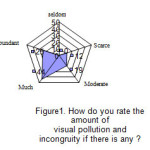 |
|
According to the Figure (1) most of the distributions in the area are average, much and very much. It should be noted that the questionnaires were handed out at three different times in the district; daytime, evening, and night time. The people who answered the questionnaires were between 20 -50 years of age.
Analyzing the issue we noticed two things. First; most people who were reluctant to take the questionnaire and apparently were in their 60s expressed total ignorance to the matter. Second, the second group who dismissed the questionnaire were people who were having a picnic with their families and felt disinclined to have their privacy disturbed. Additionally 58% of the people were bachelors of art, 32 percent were higher than MA and only 10 percent had high school Diploma. This is an indication of the respondents’ high level of knowledge. In reply to the question concerning the process of occurrence of pollution over 10 years, 24% of people taking the questionnaire suggested deteriorated circumstances and 63% suggested improved visual conditions. Also 6% of people believed that there were no significant changes and 7% of the people claimed to be totally indifferent to the matter.
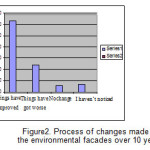 |
|
This can result from appropriate courses of action that municipalities follow to develop a coherent and integrated city. Public consensus emphasized that people’s culture and inclination have had a role in development of the environment and that an orderly and serene environment will have a positive impact on people’s morale and performance.
A study of the economic condition and the role it has in formation of visually polluted environments showed that 100% of people suggested a direct and positive relationship, only one person who was an artist himself and was engaged in environmental mural painting believed that there was not a powerful relationship between these two alternatives and depends on people’s inclination, awareness, and action. The following chart is depicting people’s inclination in approaching the matter and suggests that majority of the respondents believe in mutual collaboration between people and the authorities.
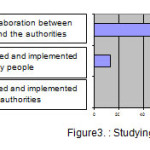 |
|
Distribution of the questionnaires at the places led to debates and conversations on how to resolve the issue of visual pollution, other solutions were also suggested like using stained glass windows, combining colored glass and wood work, and combining light and texture. at any rate activities which we have in mind are wall painting, relief and scriptures.
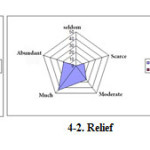 |
Figure 4 Click here to View figure |
These charts indicate that people mostly tend to like relief art and then mural painting. Calligraphy is less popular.
Figure (5) suggests that majority of people prefer stone work and clay and metal work go to next places. In figure (6) too solely artistic themes, cultural themes and social themes respectively gained the most votes.
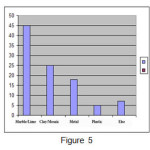 |
|
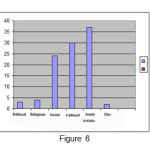 |
Figure 6 Click here to View figure |
This chart is indicating the predominant color tonality people would expect from the environment. Figure (7) suggests that nearly %40 of selections are related to combined colors. So we can conclude that color tonality should be applied according to the current setting in any place and at any time.
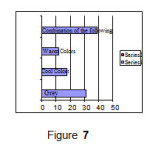 |
Figure 7 Click here to View figure |
Conclusion
Man has long been trying to change the world around him in order to access a place with better living conditions. You can imagine a time when he sought shelter in caves or a time when he sought shelter by digging the ground or placing a roof over his head to protect him from weather adversities, wild animals etc. Now compare him with modern man trying to put up an umbrella when it starts to rain. The common thread you could find between modern man and primitive man is their desire to control and harness the environment and environmental factors based on their different innate and acquired needs. Peace, beauty, integrity, order, etc are among our innate needs.
The environment we live in is a combination of different places with different applications each involving a unique anatomy. Considering the path we follow in the current debate, we can develop an integrated environment, and a desired wholeness according to its use and application. According to the studies done in the Sangfarsh Street of Vali’asr in Tabriz majority of people supported an application of graphic art and an increased capacity of the environment. Specially the two options related to use of relief and mural painting called much attention and solely artistic cultural and social themes drew the most attention.
Using graphic arts one can breathe a new spirit into the environment and achieve a more harmonized, happier, and livelier environment. First, it is recommended that spots for stopping and sitting be considered along Sangfarsh Street and next the sociable environment be decorated using relief. The sociable environment can include a coffee shop stretching across the place with its chairs and tables or chairs placed in an organic form under trees for people to rest and relax. Along the sightline of stopping spots and along the walls we can create a new sense of existence in the setting using decorations with warm colors or an area can be considered for artists to put their art on street exhibition. In this way a public awareness of art can be raised and artistic folk conversations and congregations can occur. Also by employing portable relief and wall paintings we could spread different sensations according to the mood and occasion.
Another application of relief and wall painting which can be mentioned is to create a milestone for the environment which can be used as a benchmark and give the environment an independent and unique identity.
References
- Mozafarikhah, Z. and Kafshcian moghadan, A. “Minimal Art Graphics Capabilities in the Urban Environment Graphics with Emphasis on Samples of Urban Wall Paintings,”Negare magazine, N 22. Summer (in Persian) (2013).
- Ne’matimehr, M.S. “The Principle of Wholeness in Urban Design”, Honarhaye Ziba magazine, N 22. Summer (in Persian) (2006).
- Asadi, sh. and Farrokhi, K. M. “The Challenges of Sustainable Development and Architecture,”,”International Journal of Science, Technology and Society 3 (2-1), 11-17 (2014).
- Farrokhi, K.M. and Asadi, sh. and Rashid, K.H. “ The Role of Public Urban Spaces in Creating a Vivacious Society: A Case Study in Tabriz, Iran,” European Online Journal of Natural and Social sciences,V.3, N.4, Special Issue on Architecture, Urbanism, and Civil Engineering (2014).
- Piaget, G. “ Basic Principales of Constructivism,” Arghanun press 4, Tehran, p.27-36 (in Persian) (1995).
- Bohm, D. “about Creativity,”Hoseynnajad, M.A., Saghi press, Tehran,(in Persian) (2003).
- Homayi, J. “what says Molavi,” Homa Press, Tehran, P.9, (in Persian) (2001).
- Alavinejad, M. “Comparative Studies on the Use and Modification of Architectural decoration and wall-writing in the sources of Islamic Art,” Negare press, N.5(in Persian) (2011).
- Kafshchian moghadam, A. “Study of Wall painting features,” Hnahaye Ziba Magazine, N 20 (in Persian) (2003).
- Kafshchian moghadam, A. “astudy of Tehrans Contemporary Wall painting, Before and After Revolution,” Honarhaye Ziba Magazine, N 33 (in Persian) (2010).
- Keramati, M. “Dictionary of Visual Arts,” Chakameh Press, Tehran (in Persian) (2006).
- Pakbaz, R. “Encyclopedia of Art,” Farhange Moaser, Tehran (in Persian) (2005).
- Arseh consultant. Tabriz comprehensive plan, Housing and Urbaningministary, (in Persian) (1995).






